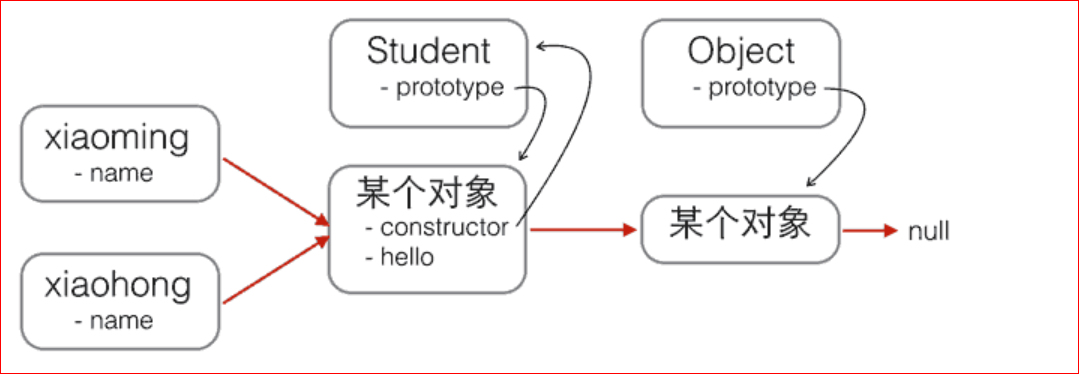JavaScript的原型链和Java的Class区别就在,它没有“Class”的概念,所有对象都是实例,所谓继承关系不过是把一个对象的原型指向另一个对象而已。
Object.create()方法可以传入一个原型对象,并创建一个基于该原型的新对象,但是新对象什么属性都没有。
var Student = { name: 'Robot', height: 1.2, run: function () { console.log(this.name + ' is running...'); } }; var s = Object.create(Student); console.log(s); //{} //__proto__: //height: 1.2 //name: "Robot" //run: ƒ () //__proto__: Object
-
创建对象
JavaScript为每个创建的对象都会设置一个原型,指向它的原型对象。
例如,创建一个Array对象: var arr = [1, 2, 3]; 其原型链是: arr ----> Array.prototype ----> Object.prototype ----> null
Array.prototype定义了indexOf()、shift()等方法,因此你可以在所有的Array对象上直接调用这些方法。
当我们创建一个函数时: function foo() { return 0; } 函数也是一个对象,它的原型链是: foo ----> Function.prototype ----> Object.prototype ----> null
由于Function.prototype定义了apply()等方法,因此,所有函数都可以调用apply()方法。
-
构造函数
JavaScript还可以用一种构造函数的方法来创建对象
1.先定义一个构造函数:
function Student(name) { this.name = name; this.hello = function () { alert('Hello, ' + this.name + '!'); } }
2.用关键字new来调用这个函数,并返回一个对象
var xiaoming = new Student('小明'); xiaoming.name; // '小明' xiaoming.hello(); // Hello, 小明! var xiaoming = Student('小明'); xiaoming.name; // undefined xiaoming.hello(); // undefined
新创建的xiaoming的原型链是:
xiaoming ----> Student.prototype ----> Object.prototype ----> null注意:如果不写new,这就是一个普通函数,它返回undefined。
但是,如果写了new,它就变成了一个构造函数,它绑定的this指向新创建的对象,并默认返回this,也就是说,不需要在最后写return this;。
用new Student()创建的对象还从原型上获得了一个constructor属性,它指向函数Student本身:
Student.prototype.constructor === Student; // true xiaoming.constructor === Student.prototype.constructor; // true
现在我们就认为xiaoming、xiaohong这些对象“继承”自Student。不过还有一个小问题,注意观察:
xiaoming.name; // '小明' xiaohong.name; // '小红' xiaoming.hello; // function: Student.hello() xiaohong.hello; // function: Student.hello() xiaoming.hello === xiaohong.hello; // false
xiaoming和xiaohong各自的name不同,这是对的,否则我们无法区分谁是谁了。
xiaoming和xiaohong各自的hello是一个函数,但它们是两个不同的函数,虽然函数名称和代码都是相同的!
如果我们通过new Student()创建了很多对象,这些对象的hello函数实际上只需要共享同一个函数就可以了,这样可以节省很多内存。
要让创建的对象共享一个hello函数,根据对象的属性查找原则,我们只要把hello函数移动到xiaoming、xiaohong这些对象共同的原型上就可以了,也就是Student.prototype:

变为

修改代码如下:
function Student(name) { this.name = name; } Student.prototype.hello = function () { alert('Hello, ' + this.name + '!'); };
-
忘记写new怎么办
为了区分普通函数和构造函数,按照约定,构造函数首字母应当大写,而普通函数首字母应当小写。
我们还可以编写一个createStudent()函数,在内部封装所有的new操作
function Student(props) { this.name = props.name || '匿名'; // 默认值为'匿名' this.grade = props.grade || 1; // 默认值为1 } Student.prototype.hello = function () { alert('Hello, ' + this.name + '!'); }; function createStudent(props) { return new Student(props || {}) }
这个createStudent()函数有几个巨大的优点:一是不需要new来调用,二是参数非常灵活,可以不传,也可以这么传:
var xiaoming = createStudent({ name: '小明' }); xiaoming.grade; // 1
-
原型继承